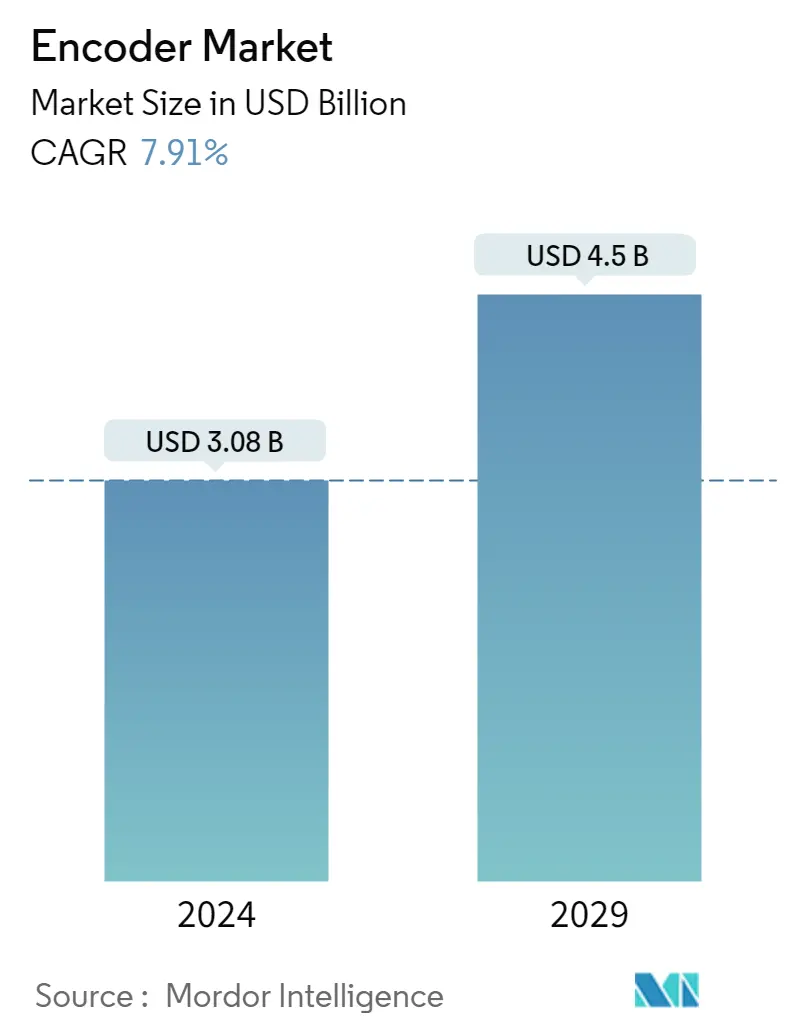Market Size of Encoder Industry

| Study Period | 2019 - 2029 |
| Market Size (2024) | USD 3.08 Billion |
| Market Size (2029) | USD 4.5 Billion |
| CAGR (2024 - 2029) | 7.91 % |
| Fastest Growing Market | Asia-Pacific |
| Largest Market | Asia-Pacific |
Major Players
*Disclaimer: Major Players sorted in no particular order |
Encoder Market Analysis
The Encoder Market size is estimated at USD 3.08 billion in 2024, and is expected to reach USD 4.5 billion by 2029, growing at a CAGR of 7.91% during the forecast period (2024-2029).
The market is witnessing rapid growth due to the increasing demand for encoders in multiple applications, from data centers to telecommunication.
- The need for high-end automation and Industry 4.0 are the major factors driving the growth of the market. Industry 4.0 describes the fourth industrial revolution, a new world where factory automation moves beyond manufacturing plants controlled by conventional information technology systems to a cloud-based infrastructure that permits big data analytics and the virtualization of production processes.
- Many countries worldwide have positively responded to Industry 4.0 by developing strategic initiatives to strengthen its implementation. For instance, SAMARTH Udyog Bharat 4.0 is an Industry 4.0 initiative of the Ministry of Heavy Industry & Public Enterprises, Government of India, under its scheme on Enhancement of Competitiveness in the Indian Capital Goods Sector. According to the UNCTAD, China and the United States are leaders in investment and capacity in Industry 4.0 technologies. They are home to the largest digital platforms, accounting for 90% of the market capitalization.
- Furthermore, encoders are central to motion control applications. They can offer feedback on position, speed, and direction to a controller or drive to increase the accuracy and reliability of a drive system. As technology advances, so do encoders, incorporating the latest developments in communications and networking and offering engineers tools to solve challenges they face across a diverse array of motion control applications.
- One of the most significant limitations of encoders is that they can be reasonably complex and comprise some delicate parts. This makes them less tolerant of mechanical abuse and restricts their allowable temperature. One would be hard-pressed to find an optical encoder that will survive beyond 120ºC. In addition to this, rising concern about functional safety issues, which is of significant importance in any motion control design, is also a notable limitation for the growth of the market as the acquisition of functional safety certification can be arduous, and there can be some errors associated with the functionality of the motion control encoders. Such limitations pose a challenge to the market's growth.
- Furthermore, the pandemic highlighted the importance of automation, and remote applications in manufacturing resulted in increased investments in automation, potentially boosting demand for various types of encoders. The rise of e-commerce and automation in sectors like warehousing and logistics is anticipated to drive demand for encoders in these applications.
Encoder Industry Overview
Encoders are components added to a direct current motor to convert the mechanical motion into digital pulses that integrated control electronics can interpret. The main purpose of encoders is to transform information from one format to another for standardization, speed adjustment, or safety control.
The encoder market is segmented by type (rotary and linear), technology (optical, magnetic, and photoelectric), end-user industry (automotive, electronics, textile, printing machinery, industrial, and medical), and geography (North America, Europe, Asia-Pacific, and Rest of the World). The market sizes and forecasts are provided in terms of value (USD) for all the above segments.
| By Type | |
| Rotary Encoder | |
| Linear Encoder |
| By Technology | |
| Optical | |
| Magnetic | |
| Photoelectric | |
| Other Technologies |
| By End-user Industry | |
| Automotive | |
| Electronics | |
| Textile | |
| Printing Machinery | |
| Industrial | |
| Medical | |
| Other End-user Industries |
| By Geography*** | |
| North America | |
| Europe | |
| Asia | |
| Latin America | |
| Middle East and Africa |
Encoder Market Size Summary
The encoder market is experiencing significant growth, driven by the increasing demand for automation and the adoption of Industry 4.0 technologies. This growth is fueled by the need for high-end automation solutions that enhance efficiency and productivity across various sectors, including manufacturing, telecommunications, and data centers. Encoders play a crucial role in motion control applications, providing essential feedback on position, speed, and direction, which is vital for the accuracy and reliability of drive systems. The market is also benefiting from the rise of e-commerce and automation in industries such as warehousing and logistics, which have seen increased investments in automation technologies. However, the complexity and sensitivity of encoders, along with concerns about functional safety, pose challenges to market expansion.
The demand for encoders is further propelled by the rapid industrialization in regions like Asia-Pacific, where countries such as China and India are expanding their manufacturing bases. Government initiatives promoting automation and Industry 4.0, along with the growth of the automotive industry, are expected to drive the market forward. Encoders are increasingly used in robotics, CNC machines, and assembly lines, contributing to improved productivity and precision in industrial applications. The presence of major global players in the encoder market, such as Omron Corporation and Honeywell, ensures a competitive landscape with continuous innovation and product development. Recent advancements, such as the launch of new encoder products designed for harsh environments and enhanced safety features, highlight the ongoing efforts to meet the evolving needs of various industries.
Encoder Market Size - Table of Contents
-
1. MARKET INSIGHTS
-
1.1 Market Overview
-
1.2 Industry Attractiveness - Porter's Five Forces Analysis
-
1.2.1 Bargaining Power of Suppliers
-
1.2.2 Bargaining Power of Buyers
-
1.2.3 Threat of New Entrants
-
1.2.4 Threat of Substitutes
-
1.2.5 Intensity of Competitive Rivalry
-
-
1.3 Industry Value Chain Analysis
-
-
2. MARKET SEGMENTATION
-
2.1 By Type
-
2.1.1 Rotary Encoder
-
2.1.2 Linear Encoder
-
-
2.2 By Technology
-
2.2.1 Optical
-
2.2.2 Magnetic
-
2.2.3 Photoelectric
-
2.2.4 Other Technologies
-
-
2.3 By End-user Industry
-
2.3.1 Automotive
-
2.3.2 Electronics
-
2.3.3 Textile
-
2.3.4 Printing Machinery
-
2.3.5 Industrial
-
2.3.6 Medical
-
2.3.7 Other End-user Industries
-
-
2.4 By Geography***
-
2.4.1 North America
-
2.4.2 Europe
-
2.4.3 Asia
-
2.4.4 Latin America
-
2.4.5 Middle East and Africa
-
-
Encoder Market Size FAQs
How big is the Encoder Market?
The Encoder Market size is expected to reach USD 3.08 billion in 2024 and grow at a CAGR of 7.91% to reach USD 4.5 billion by 2029.
What is the current Encoder Market size?
In 2024, the Encoder Market size is expected to reach USD 3.08 billion.

